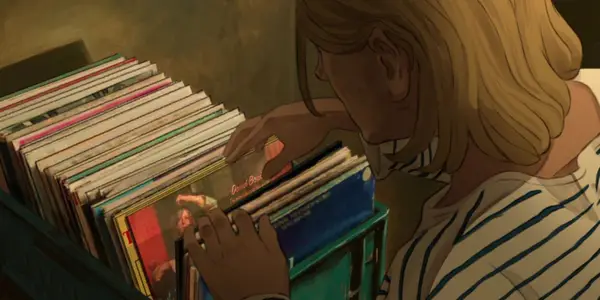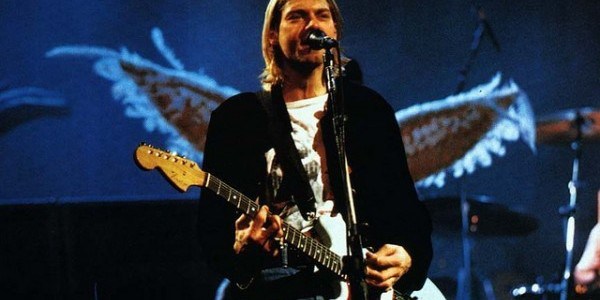KURT COBAIN: Masterpiece of Heck

Rachael Sampson is a Yorkshire screenwriter and film critic. She…
This April, Cobain: Montage of Heck, the new rock doc by Brett Morgen, was released into the world. I was a little apprehensive because I felt as if all the insight that we would be given into the life of Kurt Cobain had already been exposed. I couldn’t have been more wrong. The unique method of tracking Kurt’s life through his diary entries, artwork, home movies, unheard songs, photographs, songbooks and demos unveil a side of him we have never seen.
What makes this stand out from all the other documentaries is that it is the one and only documentary about the life of the Nirvana frontman that has had the cooperation of his family, not only in front of the camera, but behind it, with Kurt’s only child Frances Bean Cobain working as an executive producer. We all know Kurt’s life ended tragically; however, this depiction of his entire life reveals how his heart was too pure to cope with the harsh world that most of us turn a blind eye to.
Cobain’s art comes to life
A very memorable and prominent part of Montage of Heck is when an actual recording of Kurt is played over illustrations of his teenage years, and he narrates the story of his isolated life, virginity loss, rebellion, mental abuse, reliance on drugs, and previous suicide attempt. It leaves you feeling overwhelmed, hearing his voice reach out and tell a tale so difficult to discuss – yet the clarity and truth in his story is almost too harsh to hear, as he does not shy away from how he really feels. It is the blunt truth.

The animations in Montage of Heck, developed by Stefan Nadelman and Hisko Hulsing, are like nothing I have seen before. They bring his illustrations to life, literally. You see bats and creatures move about on the screen, giving the art another dimension. Recordings of the band play over visually complex animations, jumping from different pages of Kurt’s journals, revealing lines such as: “I don’t have anything to say or ask, I just play along,” “I am threatened by ridicule,” “may women rule the world,” “your government hates you,” and “punk rock means freedom,” alongside doodles and pieces of art he has created over the years.
This allows the audience to catch a glimpse of what went on in Kurt’s head, and how talented he was, not only musically but as a visual artist. It bombards you with a screen full of Kurt, causing nostalgia and a deeper understanding for the older fans who saw his fame explode, as well as insight for the newer/younger fans like myself who were not around when everything unveiled for the Nirvana frontman.
Intense interviews
Not only does this documentary provide audiences with insight from Kurt himself, but we also get thoughts and feelings from his loved ones, and their honesty and stories are just as raw as if they were telling them 21 years ago. A memorable quote said by Kurt’s mother in one of the interviews really hits hard, for nobody can prepare you for the life of being the biggest rock star in the world, as she says: “you better buckle up, ’cause you are not ready for this.” Courtney Love gives us her own stories about marital life with Kurt, alongside their family videos of the quiet and loving life they had with their baby daughter, Frances Bean.
During Love‘s interview for the documentary, you can see the tough wall she has built up over the years slowly erode away, as she speaks honestly and openly about her husband, telling us how she once thought about cheating on Kurt, and how broken he felt. It must be a hard discussion for anyone to have, yet Love powers through, and tells viewers, with a cigarette in hand, what really went on during a time when the media would do anything to be linked to their story, with tabloid lies constantly following them. The phone call of an angered and distressed Kurt telling a journalist to leave him and his family alone is included in the documentary, showing the upsetting result of the tabloids’ impassive, vulture-like behaviour that surrounded their every movement, and how it only further contributed to Kurt’s depression.

Not only has this documentary exposed Kurt in a light that fans have not seen before, it also acted as a form of healing for everyone who was affected by his death. Rock musician Krist Novoselic recently tweeted: “It is a great film. I’ve seen it twice and was blown away by the first 2/3 and hated the last 1/3. […] I have reconciled the last 1/3 of the film and now appreciate what it has done for my healing. […] Thank you Brett Morgen for pushing my buttons. It gave me the opportunity for introspection.”
21st century benefits
In today’s culture, I believe that Morgen and Love have done the right thing by taking their time, spending years working on this project, and also releasing it now, in 2015. The use of technology and editing in Montage of Heck is incredibly complex and skillful, and the clear picture and use of vibrant color captures a strong element of Cobain’s life. That is something I feel wouldn’t have been as successful if the documentary was created in the 1990’s. This is true not just because of the cinematic quality, but for the interviewees as well.
Now that is has been over 20 years since Kurt’s death, the interviewees have been able to have time to reflect and look back at his life with retrospect, making their recollections much more honest and powerful. As the researchers look into Kurt’s life through his previous works, not only are they educating fans and audiences on him, but they are also informing the people who knew him most just what kind of man he was. There is a scene within the documentary where Tracy Marander, Kurt’s ex-girlfriend, learns that he was doing heroine in 1987 when he was living with her, an unexpected insight into the man who she was in love with, decades later.

The ending of Montage of Heck had me in tears. It just makes you want to reach out, go through the screen and give Cobain a hug, as the emotion that this documentary brings out is not even close to subtle. It makes you feel privileged for the family and friends of Kurt to open up about his life, especially since they really have no need to justify his life to outsiders. And that is something I am incredibly grateful for.
What I particularly liked about the rock doc was how it focused specifically on the life of Kurt and not on his death. The only section of the documentary based around the tragedy is stated on a blank screen at the end of the film. Kurt is well known for his death, but that is not something he should be centrally remembered for. Focusing on the highs and lows on his life keep fans and audiences hooked on the person he was: a kid with a heart of gold.
This film, for me, stands out as one of a kind, and I really haven’t seen a documentary executed in this manner before. The artistry from the crew and Kurt himself is, quite frankly, a chaos of creativity that depicts him in the correct way. Brett Morgen has unveiled a masterpiece of heck with this new documentary on the life of Kurt Cobain. It’s the first documentary that I have seen by Morgen, but I am sure it will not be the last.
Have you seen Cobain: Montage of Heck? Please tell us what you think in the comments below!
(top image source: Huffington Post)
Does content like this matter to you?
Become a Member and support film journalism. Unlock access to all of Film Inquiry`s great articles. Join a community of like-minded readers who are passionate about cinema - get access to our private members Network, give back to independent filmmakers, and more.
Rachael Sampson is a Yorkshire screenwriter and film critic. She often finds herself daydreaming about Andrea Arnold's filmography or crying over The Graduate.













